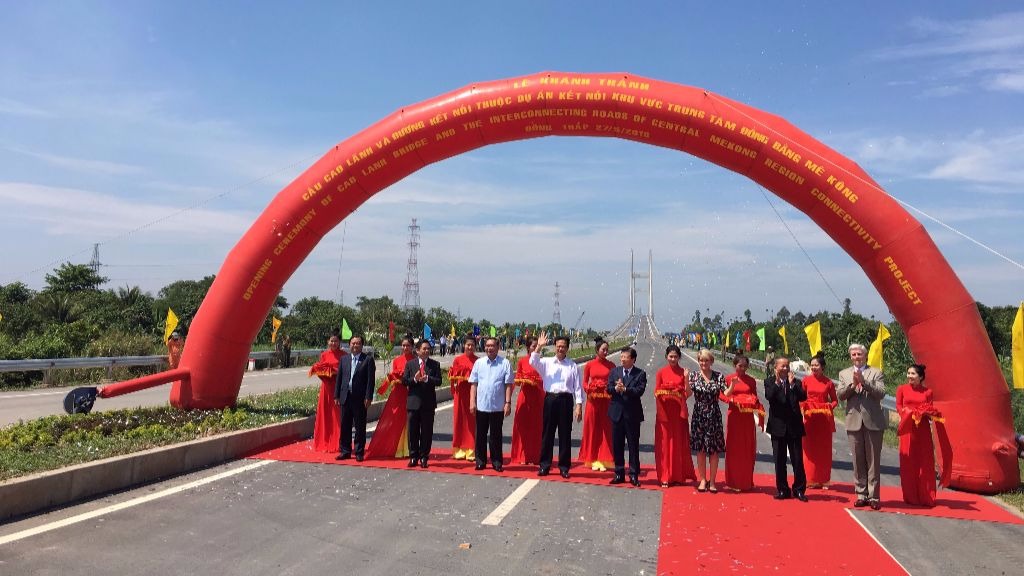Lao PDR Road Project to Improve Travel to Northern Thailand
The Lao People’s Democratic Republic will start building a section of National Road 11 that will make it easier to travel to northern Thailand.
Developing transport infrastructure in tandem with policies and procedures for crossing borders and promoting trade has been central to efforts to interconnect the Greater Mekong Subregion countries.
The Subregional Transport Forum reviews, coordinates and monitors regional transport plans and projects of GMS member countries.
Transport lies at the heart of Greater Mekong Subregion cooperation. The development of physical infrastructure, such as roads and bridges, in tandem with policies and procedures for crossing borders and developing trade along key routes, has been central to efforts to forge a truly interconnected subregion.
Physically connecting the countries of the subregion was one of the first initiatives of the GMS program when it was founded in 1992. The countries of the Greater Mekong Subregion have acknowledged that in order to cooperate in trade, tourism, and investment, and to realize the other benefits of the region, they must expand the road links and border crossings that connect them.
This is being done through the development of “economic corridors,” which are geographic areas, often along major highways, where a variety of development projects are undertaken to maximize their development benefits. This might include projects involving infrastructure, laws and regulations, market development, and the improvement of urban centers. Economic corridors bring a wide range of benefits, far beyond what single projects deliver in terms of development impact.
The three main GMS corridors—the East–West, North–South and Southern economic corridors—have improved the lives of millions of people in the Greater Mekong Subregion. These corridors are being enhanced with secondary roads that extend their benefits to nearby communities most in need, and other roads that link to strategic seaports in the subregion. The regulatory details of how people and goods can best move along these corridors are also currently being worked out.
The GMS Economic Cooperation Program Strategic Framework 2030 (GMS-2030) will prioritize intermodal approaches, facilitate cross-border transport, and seek improvement in logistics, asset management, and road safety. Given the rise in GMS economic density, and with respect to its environmental considerations, GMS-2030 aims to ensure the development of railway networks; sea, river, and dry ports; and inland waterways. Investments in airports to improve connections with the rest of Asia and the world will be essential, as will the development of secondary roads that will link to main corridors to expand the benefits to poorer communities. An effort will be made to integrate urban transport with the GMS transport network. GMS-2030 was endorsed and adopted at the 7th GMS Summit of Leaders in September 2021. It aims to provide a new setting for the development of this subregion for the next decade.
Related
• GMS Transport Sector Strategy 2030
• GMS Transport Strategy 2006–2015
Focal Persons at the Asian Development Bank
• Mohammad Nazrul Islam
• Senior Transport Specialist
Dong Kyu Lee
Director
SG-TRA
Hiraoki Yamaguchi
Senior Director
SG-TRA
Other Concerned Staff & Consultants
Antonio Ressano
Regional Cooperation and Integration Unit
Southeast Asia Department
Lucia Martin Casanueva
Regional Cooperation and Integration Unit
Southeast Asia Department/GMS Secretariat
Send inquiries to GMS Secretariat.
The Lao People’s Democratic Republic will start building a section of National Road 11 that will make it easier to travel to northern Thailand.
The Twenty-Second Meeting of the GMS Subregional Transport Forum (STF-22) was held in Mandalay, Myanmar on 21–22 June 2018.
Foreign ministers from Japan and five Mekong nations this month identified areas of cooperation under a new strategy and reviewed the progress of joint projects in the East-West Economic Corridor and Southern Economic Corridor.
A comprehensive grievance redress mechanism used a wide range of tools, institutions, and approaches to resolve project complaints and mitigate potential issues.

This study discusses the complex Grievance Redress Mechanism process in the Central Mekong Delta Region Connectivity Project in Viet Nam and tackles involuntary resettlement and environmental safeguards issues.
The Lao People’s Democratic Republic lies at the heart of the Greater Mekong Subregion and its economic corridors . However, the country has yet to maximize benefits from the subregion’s investments in infrastructure and services.
The World Bank approved in June $110 million in additional financing to improve the condition, safety, and climate resilience of a key highway in Cambodia.
BANGKOK, THAILAND (4 July 2018) — The Asian Development Bank and the Government of Thailand today signed a $99.4 million loan agreement to help the country upgrade 125 kilometers of highways and improve road safety management in the country’s northeastern region.
High upfront costs and lack of incentives impede fuel efficiency initiatives in road freight in the Greater Mekong Subregion.

Top officials at the opening ceremony included Viet Nam Deputy Prime Minister Trinh Dinh Dung, Australian Foreign Minister Julie Bishop, Secretary of Dong Thap Provincial Party Committee Le Minh Hoan, Viet Nam Transport Minister Nguyen Van The, and Country Director Eric Sidgwick of the Asian Development Bank (ADB) in Viet Nam. Photo: ADB Viet Nam Resident Mission.
Viet Nam officially opened the 2.4-kilometer Cao Lanh Friendship Bridge and connecting roads in Dong Thap province on 27 May. Crossing the Tien branch of the Mekong River, the bridge is expected to reduce travel time for some 170,000 road users daily.